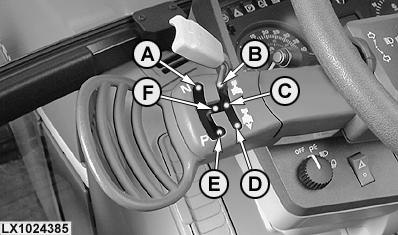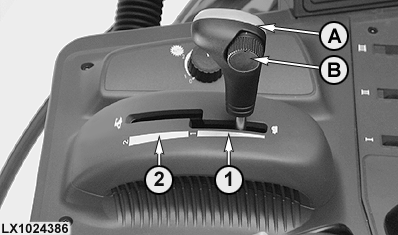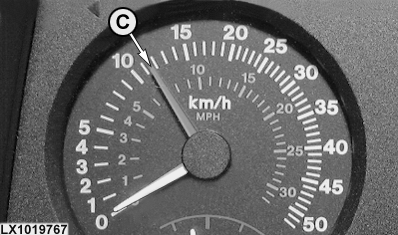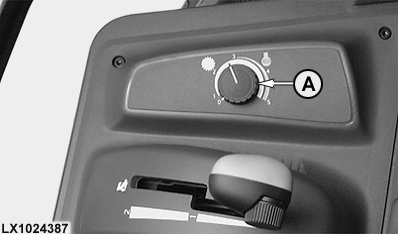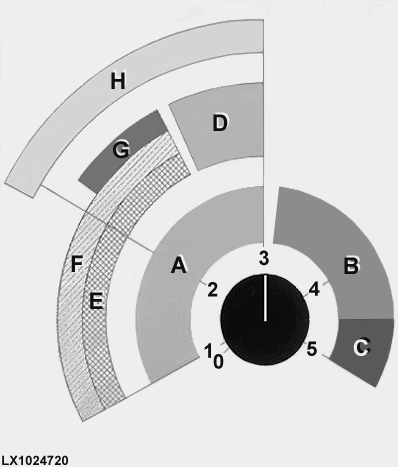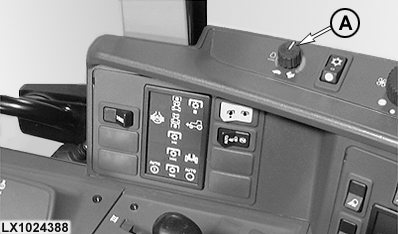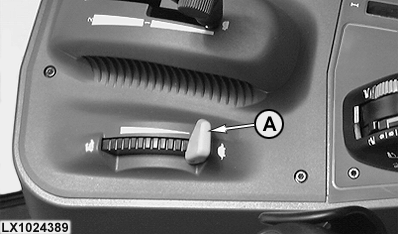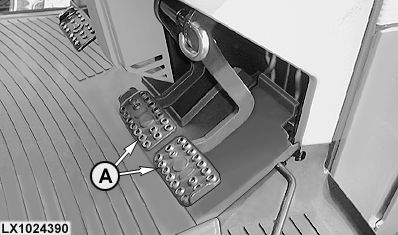AutoPowr OperationReverse Drive LeverTo drive the tractor, move the lever to Forward (B) or Reverse (D). If the lever is moved from Forward or Reverse back to the center park position (F), the tractor will continue to roll and the transmission goes to its "Power Zero" mode. Ten seconds after the tractor stops rolling, the park lock will automatically engage. If the lever is moved from Forward or Reverse directly to the corner park position (E), the tractor will brake to a stop using the transmission. The park lock will then engage. On bumpy terrain, remember to actuate the brake pedals as well. If the lever is moved from Forward or Reverse to the "Power Zero" position (C), the tractor will continue to roll but it will not be braked by the transmission. When the tractor is stationary, powerflow remains at the transmission. To obtain "Power Zero", you must hold the lever firmly in this position. If the lever is released from the "Power Zero" position, it will automatically go to the center park position (F). When the tractor is stopped, move the lever back to the corner park position. If you move it to neutral (A), the direction clutches are opened and there will be no powerflow in the transmission. The tractor may roll away. |
|
OU12401,00101BD -19-12NOV00-1/10 |
|
Speed Control Lever
Travel speed is regulated using the speed control lever. Two speed ranges are available. Speed range 1 allows a maximum forward speed of 20 km/h (12.4 mph). Speed range 2 allows a forward travel speed to be set equal to the maximum tractor speed (40 km/h or 50 km/h; 25 mph or 31 mph). The maximum speed in range 1 is always the minimum speed in range 2. In other words, there is no change in speed when ranges are changed. The maximum speed in a speed range is adjusted using speed wheel (B). For this, the engine must be running and the reverse drive lever must be in one of the following positions:
|
|
OU12401,00101BD -19-12NOV00-2/10 |
|
The maximum speed setting of a range is reached with the engine at full throttle and the speed control lever at the end of its travel in the speed range. If the accelerator pedal is not at the end of its travel, the tractor will move at a corresponding speed (not proportional). If the speed control lever is not at the end of its travel in a speed range, the tractor will similarly operate at a corresponding speed as indicated by the red needle (C). Speed wheel (B) does not have a stop and can be "infinitely" adjusted. It makes a change in relation to the previous setting. If the maximum speed setting is changed with wheel (B) while the tractor is moving, the change is always based on the last setting. Turning the wheel will directly increase or decrease the last maximum speed setting. Creeper ModeIf a forward travel speed below 2 km/h (1.24 mph) is used in speed range 1, the tractor will automatically shift to creeper mode. The possible minimum travel speed is 0.05 km/h (0.03 mph). In speed range 2, the maximum speed in creeper mode is 2.5 times greater than in range 1. In both speed ranges, the maximum speed in creeper mode 2.5 times greater than the minimum speed. For example, if a maximum speed of 0.50 km/h (0.33 mph) is set in range 1, the minimum speed is 0.20 km/h (0.12 mph). At speeds below 0.6 km/h (0.37 mph), changing engine speed does not have any effect on travel speed. The following occurs if the speed-adjusting wheel is used to increase travel speed while the tractor is in motion in range 2 with creeper mode selected:
|
|
OU12401,00101BD -19-12NOV00-3/10 |
|
OU12401,00101BD -19-12NOV00-4/10 |
|
AutoPowr Selector
AutoPowr selector (A) controls the extent to which the transmission is controlled automatically. In position 0 (manual), the only automatic intervention is to prevent stalling. In position 1, transmission control is minimally influenced by the electronic system. In position 5, transmission control is most influenced by the electronic system. The extent of transmission automation progressively increases in positions 1 to 3, between > 3 and 5 there is additional automation of engine control. Engine load control is set in positions 1 to 3. In positions 3 to 5 (Eco mode), the engine turns only as fast as needed. This results in fuel savings and noise reduction. If the operator sets a specific engine speed in eco mode and the electronic control system recognizes that this speed is not necessary, engine speed will be automatically reduced to a level adequate for tractor operation. Travel speed remains constant, however. Eco mode is not suited for lifting operations (where engine speed determines hydraulic pump output) and PTO operation (where engine speed directly determines PTO speed). In eco mode, you can override the set engine speed by operating the accelerator pedal hand throttle at the same time. Position 0 - Manual control of transmission Position 1 - Approx. 30% engine load control before transmission engages. Position 2 - Approx. 18% engine load control before transmission engages. Position 3 - Approx. 5% engine load control before transmission engages. Position > 3 - Approx. 12% engine load control before transmission engages. Engine speed can be reduced electronically by 200 rpm in the partial load range. |
|
OU12401,00101BD -19-12NOV00-5/10 |
|
Position 4 - Approx. 12% engine load control before transmission engages. Engine speed can be reduced electronically by 650 rpm in the partial load range. Position 5 - Approx. 12% engine load control before transmission engages. Engine speed can be reduced electronically to 1200 rpm in the partial load range. |
OU12401,00101BD -19-12NOV00-6/10 |
|
The following list shows which automation settings are suitable for various types of tasks. Sector A - PTO operation Sector B - Towing operations with hydraulic power requirements Sector C - Any towing operation (field or road) without any hydraulic power requirement (since hydraulic power is not sufficient at an engine speed of 1200 rpm) Sector D - PTO operation, with precise PTO speeds (for example, when using a manure spreader) Sector E - Operation of large balers Sector F - Tillage Sector G - Operation of mowers Sector H - Other operations requiring hydraulic power (e.g. use of front loaders)
Sectors E, F and G are suitable for work in which the engine's flywheel mass is adequate to meet transient peaks in the power requirements (caused by the implement or task in hand). The following may be regarded as basic settings: Position 2.5 - Operations where engine speed is important. Position 5 - Operations where engine speed is irrelevant. |
|
OU12401,00101BD -19-12NOV00-7/10 |
|
Cruise Control
Maximum engine speed can be limited for PTO operation by means of cruise control (A). Move the hand throttle lever to full throttle, set the cruise control to position 1 - 3 as required, then reduce engine speed by turning cruise control (A). In the lowest setting, engine speed is limited to 1100 rpm. In the highest setting, the engine can run at maximum speed. Individual engine speed limits can be set between these two positions. If no PTO operation is taking place, cruise control (A) should be in the "Off" position. Travel speed remains constant regardless of any engine speed limitation. |
|
OU12401,00101BD -19-12NOV00-8/10 |
|
Accelerator Pedal and Hand Throttle
The stronger signal is always used for transmission control. If the accelerator pedal or hand throttle are moved to command a higher engine speed, engine speed increases. In Eco mode, once the set travel speed is reached, engine speed is reduced again (load controlled). If the reverse drive lever is in Forward or Reverse, the tractor can be accelerated to the set speed using the accelerator pedal or hand throttle. The immediate travel speed is directly dependent on the setting of the accelerator pedal or hand throttle. Engine speed is only indirectly determined by the position of the accelerator pedal. Thus when using the accelerator pedal or hand throttle, the values set with the AutoPowr selector and cruise control are always taken into consideration. Therefore, the value set using the cruise control cannot be exceeded even at full throttle. In Eco mode, the engine turns only as fast as needed, even if the operator applies full throttle. |
|
OU12401,00101BD -19-12NOV00-9/10 |
|
Brake Pedals
If when driving the tractor both brake pedals are depressed, the tractor's speed will be reduced until it stops. Thanks to the automatic clutch function, there is no need to depress the clutch pedal when braking. When the brakes are released again, the tractor automatically accelerates up to the speed currently commanded by the hand throttle or accelerator pedal. The higher the engine speed, the greater is the force required at the brake pedals to stop the tractor.
Clutch Pedal The clutch pedal normally does not need to be depressed to stop the tractor. If the clutch pedal is depressed, the corresponding clutch signal has priority over other commands. |
|
OU12401,00101BD -19-12NOV00-10/10 |
